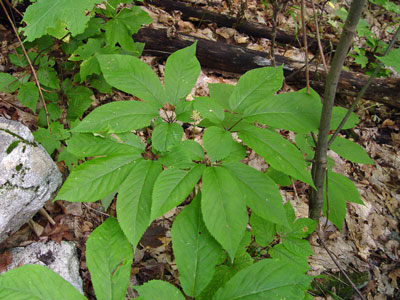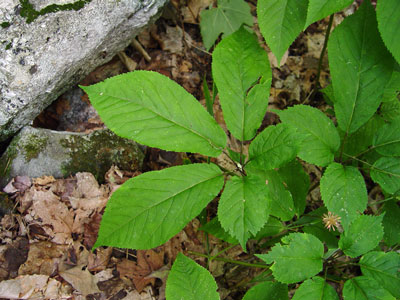DACF Home → Bureaus & Programs → Maine Natural Areas Program → Communities, Plants, and Animals → Rare Plants → Panax quinquefolius

Panax quinquefolius L.
American Ginseng
- State Rank: S3
- Global Rank: G3G4
- State Status: Endangered
Habitat: Rich, shady northern hardwood forests. [Hardwood to mixed forest (forest, upland)]
Range: Eastern North America, south to northern Florida and occasionally west to Manitoba. Primarily a species of the Appalachian hardwood forests.
Aids to Identification: Ginseng is a fleshy-rooted herb that grows about 25 cm high and bears several palmately compound leaves at the top of the stem. The five leaflets are elongate-oval in shape with the lowermost two smaller than the upper three. The small, yellowish-green flowers are borne in an umbel on a short stalk above the leaves and develop into bright red berries. Ginseng is most likely to be confused with its close relative, wild sarsaparilla (Aralia nudicaulis), which is present in almost any upland woods in Maine. Wild sarsaparilla also has five leaflets, but these are pinnately arranged, i.e., the lowest two are separated from the upper three, and its flowers are borne on a leafless stem.

Ecological characteristics: Ginseng occurs in rich hardwood forests where the soils are locally enriched with nutrients. Sugar maple, yellow birch, and white ash are the most common tree associates; basswood often occurs and can be a good indicator species. Ginseng often occurs at the base of rock outcrops or hillslopes where nutrient-rich colluvium has collected. Herbaceous plants often growing with ginseng include Goldie's fern (Dryopteris goldiana), silvery spleenwort (Deparia acrostichoides), and blue cohosh (Caulophyllum thalictroides). The plant does not spread vegetatively, and most known ginseng populations in Maine consist of fewer than a dozen plants.
Phenology: Herbaceous perennial; flowers in June, fruits ripen in September.
Family: Apiaceae
Synonyms: None noted.
Known Distribution in Maine: This rare plant has been documented from a total of 33 town(s) in the following county(ies): Androscoggin, Franklin, Kennebec, Oxford, Penobscot, Piscataquis, Somerset, York.
Reason(s) for rarity: Naturally rare because it is near the northern limit of its range, and there is scarcity of suitable forest microhabitat. Several sites have declined or disappeared due either to harvesting the plants for their roots or to heavy cutting of the forest habitat.
Conservation considerations: Recent interest in ginseng as a cash crop may lead to woodland plantings of this species. All planted populations should be carefully documented so as not to be confused with native populations in the future. Natural Maine populations are not large or vigorous enough to sustain harvesting.